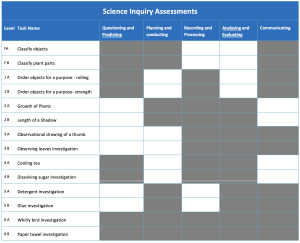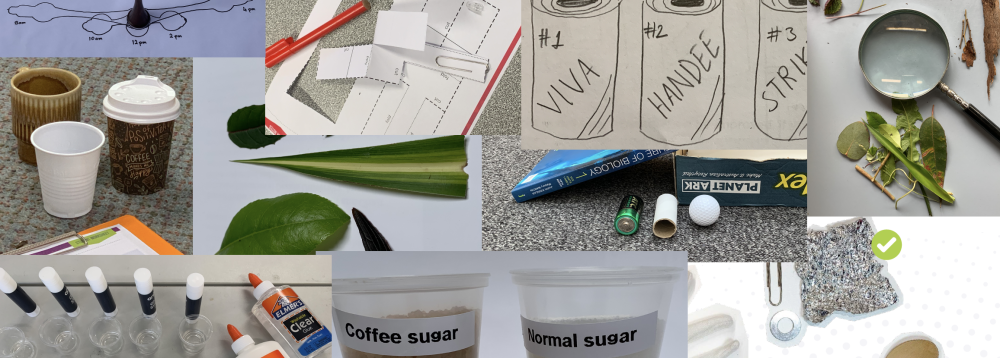Science Inquiry Assessment
Science inquiry is increasingly recognised as a critically important aspect of a science education. Students need not only to be introduced to the concepts of science through which we understand the world, but also to the inquiry practices through which science has investigated and established this knowledge. For students to be literate in interpreting and using science in their lives, they need to be aware of how science operates. This is increasingly important in these times of unlimited access to social media and the fake news that can be promoted.
Often, with practical activities in science, the focus is on illustrating concepts without special attention to developing investigative practices. Even with activities where students develop their own inquiries or aspects of these, the particular inquiry practices are often neither independently focused on nor assessed, reducing the opportunity to systematically develop students’ capabilities with inquiry.
These inquiry assessment tasks have three aims:
-
- To help teachers and students clarify the meaning of different aspects of science inquiry practices; what these involve and how they might be recognised and assessed as a progression. They can help develop for teachers a language to discuss science inquiry practices and outcomes.
- To provide the tools for assessing student inquiry at different points in the primary years. These can be used to track student inquiry learning over time.
- To provide exemplar inquiry activities that can develop students’ inquiry practices in contexts that engage their interest. These can be used to stimulate the development of further inquiry activities in a range of topics.
How to use the Science Inquiry Tasks
The tasks are designed to be used independently of curriculum units, matched to different year levels and covering a range of inquiry practices.
The SIA tasks are applied across years F – 6 assessing relevant outcomes. See Figure below.

SIA Tasks can be matched to curriculum topics by utilising them flexibly at different year levels. Most could be adapted to focus on skills at higher or lower levels.
Tasks are designed to focus on three of the science inquiry skills. However, they can be adapted to focus on other skills and, depending on the assessment processes used, one or two skills might be of particular focus. For the Grade 6 tasks, rubrics are produced for all 5 inquiry skills but teachers would preferably choose from these rather than attempt to track them all.
Assessment can involve multiple data sources: field notes as students’ work on tasks; notes on student productions; students’ answers to questions; and presentations of group reports.
The tasks and advice to teachers assume that teachers interact with students to scaffold their inquiries but make judgments about the extent of support needed. Similarly, they are group tasks but students report individually, so that judgments need to be made about the role of each student in a group.
The tasks are designed around activities that are intrinsically captivating for students, but this depends on teachers constructing a narrative to bring these to life. For this, open questioning and introductory discussions to provide ways into the activity are important.
Teachers need to make judgments about the nature and specificity of the introductory discussions to support students to the point where they can productively engage with the tasks. The support for students may be at this whole class level, but during the tasks also tailored to particular students and groups so that ideally each student works at their own level. This support might be through targeted questioning, modelling, or suggestions and encouragement to pursue specific directions.
Prior to engaging with the tasks teachers need to be clear about its purposes and the levels of student inquiry practices that could be encouraged/engaged with. Students will of course come up with surprising and inventive ideas, and care should be taken to not constrain these possibilities.
The SIA tasks are represented as a whole document or divided into its component parts for ease of management. There are two tasks per level from Foundation to level 6. They are represented on the following pages.
There is a whole document, teacher notes with student work samples, a presentation slide for use with students, the student worksheet, and the assessment rubrics presented in two different templates.
History of Refinement and Validation
The original version of these tasks were developed in-house by the Victorian Department of Education and Training (DET) staff and were used in the DET Primary Mathematics and Science Specialist (PMSS) program to assess students’ growth in science inquiry as a result of that program, in the first few cohorts. While the tasks were appreciated by the PMSS Science specialists, there were concerns about the practicality of some tasks in terms of equipment, and the time it took for task completion. Following those first implementations of the SIAs, the Deakin team progressively modified the tasks to streamline their structures, based on a desktop review, and feedback by the PMSS science specialists, including group discussions about the validity of the task judgements as a basis for summative assessment.
